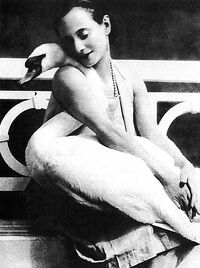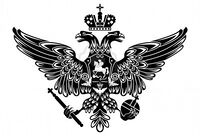Anna Pavlova (ballet dancer)
This article is on the ballet dancer. For other use see Anna Pavlova.
Anna Pavlova (January 31, 1881 – January 23, 1931) was a Russian dancer most famous for her execution of the Dying Swan at Moscow's Bolshoi Ballet. The living ones are harder to imitate on stage.
Early years[edit]
Pavlova was born to an ordinary Moscow family on the evening of February 5, 1880. We do not know who her father was, but somehow we know he died after his daughter's second birthday.
Pavlova's early life is characterized by her struggle to enter ballet school. She achieved that only when she was 10, because her inexperienced teachers were unable to identify the talent Anna was carrying. This was bad government that might have sparked a revolution. But Anna did not start it: she fought for her rights and finally got admitted in the Imperial Ballet School which was supposed to teach her how to dance.
Her passion for this art was born when her mother took her to several ballet performances. Anna found them boring and thought that, if she began dancing herself, she could get out of these engagements.
Career[edit]
Despite her indisputable talent, Anna could not obey the simplest rules her teachers gave her, such as not bending her knees. She invented a new ballet technique, which consisted of combining successful and unsuccessful tricks of other dancing masters. However, she became famous only several years later, when, during one of the performances, she fell into a prompter's box. This was indeed more interesting to look at than normal ballets.
After several such accidents, one of her teachers declared her unable to learn and told her to abandon hopes of a dancing career. Regardless, Anna took a role from Mathilde Kschessinska, who turned up pregnant. Finally, in 1906, Pavlova was named prima ballerina and demanded a bigger dressing room.
Pavlova formed her own ballet company, which remains anonymous. She and the members of the company performed throughout the world. Although her mother was a member of the Russian proletariat, the Communists became angry at her when she refused to perform Marx's and Bakunin's works. For this reason, she moved to England in 1912 and never returned to Russia. The Communists ruined her reputation by spawning a rumour that her father was Jewish. This part of her life was called the "awakening."
Eventually, her company disbanded. One of the causes was the fact that several young ballerinas wanted to imitate Anna and fell from the scene. However, this had no significant effects, except for a few broken necks. Anna herself was reduced to various solo performances around the world.[1]
At that time, Pavlova devised a better way to perform the role of the Dying Swan and purchased several swans, which she kept in her house in England. Afterward several people heard birds crying in the ballerina's yard, but animal rights was not as refined in those days.
Death[edit]
When Pavlova was almost fifty, doctors said she would die of pneumonia without an urgent surgery. But she again defied the recommendations of those professionals, and died only four years later, of pleurisy. This tragic event happened in the company of her closest friends. They were Victor Dandré,[2] her doctor, and her maid.
Several minutes before her death, she decided to perform the role of the Dying Swan again. Her last words were to demand, "Get my 'Swan' costume ready!" Pavlova's final performance was reportedly the most natural ever.
The British Government thought that Pavlova was killed by Dandré, who had her body cremated, surely to destroy evidence.
After her death, the Russian Government asked to move the ashes to Moscow, but Great Britain refused. Finally, in 2001, Russia resurrected these plans but, as Vladimir Putin had already taken the presidency, these plans were never realised.
Sport[edit]
One surprising Pavlova legacy is the adoption of her rendition of the Dying Swan by football players throughout England when tackling for the ball. It usually comes in three stages: the Trip, the Dive (or 'the Jurgen') and the Dying Swan. Unlike the first two, whose execution can be measured in seconds, the Dying Swan itself can last a full five minutes. The dancer hopes to gain an advantage from stopping play, wasting time, getting an opponent to receive a red card, or all three.
Legacy[edit]
Pavlova has a New Zealand dessert named after her. This dish has started several wars with Australia, which falsely claims ownership of the dish.
Pavlova's house was marked as a site of 'significant historical interest.' This was done by Anna's maid, who did not want to do any more tidying up after her mistress died.
Pavlova's best-known performance was on the back of a moving elephant, an animal that can still be seen in the museum.
Finally, there are at least 5 memorials to Anna in London. But none in Russia.
Footnotes[edit]
- ↑ This is when the people in New Zealand invented their "Anna Pavlova" dessert, now an important part of the country's cuisine, but officially introduced it only after Pavlova's death, when they no longer needed her permission.
- ↑ Someone who asserted that he was her husband, though Anna never confirmed it.



